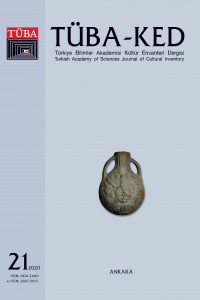Abstract
Beyoğlu, İstiklal Caddesi’ndeki Hüseyin Ağa Camii’nin bahçe duvarı köşesinde, Atıf Yılmaz Caddesi (Sakız Ağacı Caddesi) üzerinde bulunan çeşme, kaynaklarda cami ile aynı döneme, 16.yüzyıla tarihlendirilmiştir. Osmanlı Arşivi’nde tespit edilen yazışmalar, keşf-i evvel defteri ve uygulanması planlanan çizimleri, çeşmenin 1880 yılında inşa edildiğini göstermektedir. Çeşmenin süslemeleri ve üzerindeki silik olan ve kısmen okunabilen tarih de bu tarihle uyumludur. Çeşme için Evkaf-ı Hümâyun tarafından hazırlanmış olan ilk projenin, masraflı olacağı gerekçesiyle uygulanmadığı; Beyoğlu Altıncı Belediye Dairesi tarafından hazırlatılan ikinci projenin ise değişikliklerle kısmen uygulandığı anlaşılmaktadır. Tek yüzlü, depolu/hazneli duvar çeşmesi olan ve caminin adıyla kaynaklarda tanımlanan çeşmenin süslemeleri de dönemi ile örtüşmektedir. Çeşmenin ayna taşındaki baklava dilimli geometrik düzenleme ortasında yer alan küp/vazo süslemesi de bu çeşmeye özgüdür. Çeşmenin keşf-i evvel defterinde, caminin karşısında, aynı cadde üzerinde yanmış başka bir çeşmenin bulunduğu ve mevcut yanık çeşmenin malzemesinin de yeniden inşa edilecek olan bu çeşmede kullanılacağı ifade edilmiştir. Yerinde yapılan incelemede, çeşmenin duvar yüzeyinde, musluk yerleri belli olan ayna taşı tespit edilmiştir. Çeşmenin inşası da tanımlanan çeşmenin yanması üzerine gündeme gelmiştir. Hüseyin Ağa Camii Çeşmesi’nin inşa sürecinde, dönemin vakıf baş mühendisi olduğu tespit edilen A. N. Perpignani de bir proje hazırlamıştır. Makalede, Hüseyin Ağa Camii Çeşmesi’nin mimari ve süsleme özellikleri tanımlanacak; çeşmenin inşa süreci ve tarihi ile hazırlanmış olan orjinal projeleri ele alınacak; son dönem Osmanlı mimarlığında çalışmalarıyla tanınan mimar Perpignani’nin bu çeşme ile bağlantısına değinilecektir.
References
- Başkanlık Osmanlı Arşivi (BOA.), ŞD., 101/4, H. 1297, M. 1880.
- BARUH, L.T., 2018., “Mülkiyet, Finans ve Mimarlık: Osmanlı Bankası Şube Binaları”, Toplumsal Tarih, 290, s. 26-35.
- BAYFİDAN, D., 2018., 19. Yüzyıl Beyoğlu Çeşmeleri, (Yayınlanmamış yük- sek Lisans Tezi) Pamukkale Üniversitesi, Sosyal Bilim- ler Enstitüsü, Denizli.
- CAN, C., 1993, İstanbul’da 19.Yüzyıl Batılı ve Levanten Mimar- ların Yapıları ve Koruma Sorunları, Yıldız Teknik Üniversitesi Fen Bilimleri Enstitüsü, Yayınlanmamış Doktora Tezi, İstanbul.
- EGEMEN, A., 1993., İstanbul’un Çeşme ve Sebilleri, İstanbul.
- SÖNMEZ, Z., 2006., Türk-İtalyan Siyaset ve Sanat İlişkileri, İstanbul.
- PİLEHVARİAN, N. K., ve URFALIOĞLU, N., 2000, Osmanlı Başkenti İstanbul’da Çeşmeler, İstanbul.
- TANIŞIK, İ.H., 1945, İstanbul Çeşmeleri II, Beyoğlu ve Üsküdar Cihetleri, İstanbul.
- TÜFEKÇİ, D., 2015, Huber Köşkü Yerleşkesi Tarihi ve Mimarisi Hak- kında: (Belgeler Üzerinden Bir Araştırma), (Yayın- lanmamış yüksek Lisans Tezi) Fatih Sultan Mehmet Üniversitesi, Mühendislik ve Fen Bilimleri Enstitüsü, İstanbul.
- TUNCER ULUDAĞ, S. ve YILMAZ, H.E., 2014, “Taksim’deki Hüseyin Ağa Camii ve Son Restorasyon Çalışmaları”, Vakıf Restorasyon Yıllığı, 2014/ 8, s. 30-43.
- YAZICI METİN, N., 2019, Devlet Kapısı, Tanzimat’tan Cumhuriyet’e Hükümet Konaklarının İnşa Süreci ve Mimarisi, İstanbul.
- YÜKSEL, İ. A., 1998, “Ağa Camii”, Türkiye Diyanet Vakfı İslam Ansiklo- pedisi, C. 1, s. 453, İstanbul.
Details
| Primary Language | Turkish |
|---|---|
| Subjects | Cultural Studies |
| Journal Section | Research Articles |
| Authors | |
| Publication Date | September 17, 2020 |
| Submission Date | May 15, 2020 |
| Published in Issue | Year 2020 Issue: 21 |
Publisher
Vedat Dalokay Caddesi No: 112 Çankaya 06670 ANKARA
TÜBA-KED Turkish Academy of Sciences Journal of Cultural Inventory (TÜBA-KED) does not officially endorse the views expressed in the articles published in the journal, nor does it guarantee any product or service advertisements that may appear in the print or online versions. The scientific and legal responsibility for the published articles belongs solely to the authors.
Images, figures, tables, and other materials submitted with manuscripts must be original. If previously published, written permission from the copyright holder must be provided for reproduction in both print and online versions. Authors retain the copyright of their works; however, upon publication in the journal, the economic rights and rights of public communication -including adaptation, reproduction, representation, printing, publishing, and distribution rights- are transferred to the Turkish Academy of Sciences (TÜBA), the publisher of the journal. Copyright of all published content (text and visual materials) belongs to the journal in terms of usage and distribution. No payment is made to the authors under the name of copyright or any other title, and no article processing charges are requested. However, the cost of reprints, if requested, is the responsibility of the authors.
In order to promote global open access to scientific knowledge and research, TÜBA allows all content published online (unless otherwise stated) to be freely used by readers, researchers, and institutions. Such use (including linking, downloading, distribution, printing, copying, or reproduction in any medium) is permitted under the Creative Commons Attribution-NonCommercial-NoDerivatives 4.0 International (CC BY-NC-ND 4.0) License, provided that the original work is properly cited, not modified, and not used for commercial purposes. For permission regarding commercial use, please contact the publisher.

